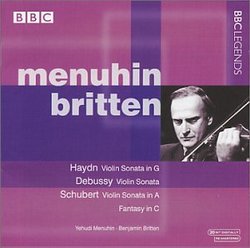| All Artists: Claude Debussy, Franz Schubert, Yehudi Menuhin, Benjamin Britten Title: Haydn: Violin Sonata in G, Debussy: Violin Sonata Members Wishing: 0 Total Copies: 0 Label: BBC Legends Release Date: 1/22/2002 Genre: Classical Styles: Chamber Music, Historical Periods, Classical (c.1770-1830), Modern, 20th, & 21st Century, Instruments, Strings Number of Discs: 1 SwapaCD Credits: 1 UPC: 684911408324 |
Search - Claude Debussy, Franz Schubert, Yehudi Menuhin :: Haydn: Violin Sonata in G, Debussy: Violin Sonata
 | Claude Debussy, Franz Schubert, Yehudi Menuhin Haydn: Violin Sonata in G, Debussy: Violin Sonata Genre: Classical
This is a legendary recording of two great, though very different artists and longtime friends. Captured live at Britten's 1957 and 1959 Aldeburgh Festivals, the performances have the sort of spontaneity that results from ... more » |
Larger Image |
CD Details
Synopsis
Amazon.com
This is a legendary recording of two great, though very different artists and longtime friends. Captured live at Britten's 1957 and 1959 Aldeburgh Festivals, the performances have the sort of spontaneity that results from close rapport and mutual trust rather than meticulous rehearsal. Each player preserves his individual style while remaining fully responsive to the other's momentary inspiration. Both were consummate masters of their instrument. Menuhin's tone is at its glorious best, though he sounds a bit distant at first; Britten's has both power and delicacy and enormous variety of color and nuance. Though faithful to the letter of the score, they seek out the spirit of the music with courageous freedom and imagination. Haydn's only original sonata for violin and piano has charm and style. The Debussy Sonata is marvelous, full of color, atmosphere, character, rhythmically flexible but steady, carefully detailed yet cast in one big sweep. Schubert's A-major Sonata is lovely: charming, elegant, free, expansive, fragrantly poetic and rapturously romantic. The great C-major Fantasy is one of the most difficult works in the literature. Half bravura showpiece, half intimate chamber music, it demands both brilliance and utmost musical sensibility. Though these players have both in abundance (never mind that Britten stumbles over some of the technical hurdles), their virtuosity is entirely at the service of the music. One might question a few of their choices of tempo and character, and it seems strange that they ignore the opportunity to bring out the Variations' conversational aspect by emphasizing different voices in the repeats. But the phrasing, liberties, and transitions are perfect; the sound is beautiful; the expressiveness, whether robust, mysterious, or tender, is always born of a deep love for the music. --Edith Eisler

 Track Listings (13) - Disc #1
Track Listings (13) - Disc #1